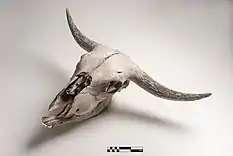Bovinae
Bovines (subfamily Bovinae) comprise a diverse group of 10 genera of medium to large-sized ungulates, including cattle, bison, African buffalo, water buffalos, and the four-horned and spiral-horned antelopes. The evolutionary relationship between the members of the group is still debated, and their classification into loose tribes rather than formal subgroups reflects this uncertainty. General characteristics include cloven hooves and usually at least one of the sexes of a species having true horns. The largest extant bovine is the gaur.
| Bovines | |
|---|---|
.jpg.webp) | |
| African buffalo (Syncerus caffer) | |
| Scientific classification | |
| Kingdom: | Animalia |
| Phylum: | Chordata |
| Class: | Mammalia |
| Order: | Artiodactyla |
| Family: | Bovidae |
| Subfamily: | Bovinae J. E. Gray, 1821 |
| Tribes | |
| |
In many countries, bovid milk and meat is used as food by humans. Cattle are kept as livestock almost everywhere except in parts of India and Nepal, where they are considered sacred by most Hindus. Bovids are used as draft animals and as riding animals. Small breeds of domestic bovid, such as the Miniature Zebu, are kept as pets. Bovid leather is durable and flexible and is used to produce a wide range of goods including clothing and bags.
Systematics and classification

- Family Bovidae
- Subfamily Bovinae
- Tribe Boselaphini
- Genus Tetracerus
- Four-horned antelope, Tetracerus quadricornis
- T. q. quadricornis
- T. q. iodes
- T. q. subquadricornis
- Four-horned antelope, Tetracerus quadricornis
- Genus Boselaphus
- Nilgai, Boselaphus tragocamelus
- B.t. tragocamelus (Indian nilgai)
- Nilgai, Boselaphus tragocamelus
- Genus †Duboisia
- †D. santeng
- Genus Tetracerus
- Tribe Bovini
- Genus Bubalus
- Wild water buffalo, Bubalus arnee
- Domestic water buffalo, Bubalus bubalis
- Lowland anoa, Bubalus depressicornis
- Mountain anoa, Bubalus quarlesi
- Tamaraw, Bubalus mindorensis
- Cebu tamaraw†, Bubalus cebuensis
- Genus Bos
- Aurochs, Bos primigenius
- Eurasian aurochs†, Bos primigenius primigenius
- Indian aurochs†, Bos primigenius namadicus
- Banteng, Bos javanicus
- Gaur, Bos gaurus
- Gayal, Bos frontalis
- Yak, Bos grunniens
- Wild yak, Bos mutus
- Bos palaesondaicus†,
- Kouprey, Bos sauveli
- Domestic cattle, Bos taurus
- Taurine cattle, Bos taurus taurus
- Zebu, Bos taurus indicus
- Aurochs, Bos primigenius
- Genus Pseudoryx
- Saola, Pseudoryx nghetinhensis
- Genus Syncerus † (extinct)
- African buffalo, Syncerus caffer
- Giant buffalo, Syncerus antiquus†
- Genus Bison
- American bison, Bison bison
- European bison, Bison bonasus
- Bison palaeosinensis†, (extinct)
- Steppe wisent†, Bison priscus
- Ancient bison†, Bison antiquus
- Long-horned bison†, Bison latifrons
- Genus Pelorovis† (extinct)
- Pelorovis oldowayensis†
- Pelorovis turkanensis†
- Pelorovis kaisensis†
- Pelorovis howelli†
- Genus Bubalus
- Tribe Tragelaphini
- Genus Tragelaphus (antelope-like)
- Bongo, Tragelaphus eurycerus
- Greater kudu, Tragelaphus strepsiceros
- Bushbuck, Tragelaphus scriptus
- Lesser kudu, Tragelaphus imberbis
- Mountain nyala, Tragelaphus buxtoni
- Nyala, Tragelaphus angasii
- Sitatunga, Tragelaphus spekeii
- Genus Taurotragus
- Common eland, Taurotragus oryx
- Giant eland, Taurotragus derbianus
- Genus Tragelaphus (antelope-like)
- Tribe Boselaphini
- Subfamily Bovinae
Etymology
Bovine is derived from Latin bos, "ox", through Late Latin bovinus. Bos comes from the Indo-European root *gwous, meaning ox.
References
- International Commission on Zoological Nomenclature (2003) Opinion 2027 (Case 3010). Usage of 17 specific names based on wild species which are pre-dated by or contemporary with those based on domestic animals (Lepidoptera, Osteichthyes, Mammalia): conserved. Bull. Zool. Nomencl., 60:81–84.
External links
- Bovinae information in ITIS.
- Congress on Controversies in Bovine Health, Industry & Economics (CoBo)